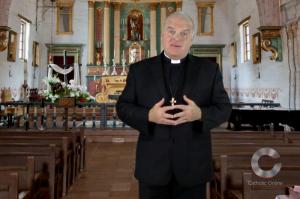Mageddo
FREE Catholic Classes
Chanaanite city, called in Hebrew, Megiddo ; in Septuagint, Mageddó(n) ; in Assyrian, Magiddu, Magaddu; in the Amarna tablets, Magidda and Makida; and in Egyptian, Maketi, Makitu, and Makedo.
Derivation
Gesenius (Thes., p. 265) derives from root GDD which is in Hithpahel–"collect in crowd" ( Jeremiah 5:7 ), and from which gedud –"troop", is derived. Hence Megiddo– locus turmarum . Others derive from gdd –"cut", and compare with kekoptomenos of Septuagint at Zach., xii, 11. This suggests a survival of the name in the Náhr-ul-M&úqáttá‘, the ancient Cison (cf. Smith, "Historical Geography of Holy Land", p. 387).
History
Mageddo, situated on the torrent Qina, on the east of the Plain of Esdraelon opposite Jezrahel, commanded the central of the three passes that join the plain with the seaboard. This pass, which offered the best and shortest route from Egypt and the south to Northern Syria, Phœnecia, and Mesopotamia, was that commonly followed by the Assyrians, Egyptians, Philistines, Greeks, and Romans, and in modern times Napoleon's passage slightly to the north was feasible only because no Mageddo threatened his rear. The same route served for caravans from the days of the "Mohar, the Egyptian traveller" under Rameses II ("Records of the Past", II, 107 sq.; Max Müller, "Asien und Europa", 195 sq.) and of St. Paula, A.D. 382 ("Life" by St. Jerome, IV).
As the key to so important a pass, Mageddo must have been fortified long before the invasion of Thotmes I, about 1600 B.C. . Thotmes III after a vigorous forced march, defeated the Syrian princes rallied there under the prince of Cades, and on the following day they stormed the place, which he declared to be "worth a thousand cities". Traces of his assault are still visible on the ruins of the citadel (Müller, "Asien", 275; "Records", I, II, pp. 35- 47). On the arrival of the Israelites Mageddo had a king of its own; they slew him, but the town proving impregnable was later subjected to tribute ( Joshua 12:21 ; 17:12 , Judges 1:27-28 ). Though situated in the teritory of Issachar it was assigned to Manasses. The position chosen by Sisara for battle with Barac shows that Mageddo was friendly to him ( Judges 5:19 ). Solomon, who rebuilt the walls ( 1 Kings 9:15 ; Jos., "Ant.", VIII, vi, 1) assigned this with other cities to Bana, the fifth of his governors ( 1 Kings 4:12 ). In the fifth year of Roboam Mageddo was captured by Sesac (Shoshenq, I-XXII Dyn.), as seen from lists at Karnak (Maspero, "Histoire", II, 774; Winckler, "Geschichte Israels", I, 160, but cf. "Encyc. Bibl.", s.vv. "Egypt" and "Shishak"). Following 2 Kings 9:27 , Ochozias died at Mageddo (but contrast 2 Chronicles 22:9 ). Finally early in the seventh century Josias tried to bar near Mageddo the advance of the Pharao Nechao towards Mesopotamia and "was slain when he had seen him" ( 2 Kings 23:29-30 ; 2 Chronicles 35:22 ; Jos., "Ant.", X, v, i; Max Müller, "Mittheil. d. Vorderas. Gesell.", III, 1898, p. 56; but against cf. Zimmern and Winckler, "Die Keilin. und A. T.", 105, who follow Herodotus, II, clix). The mourning for this calamity became proverbial ( Zechariah 12:11 ). The warlike reputation of Mageddo is perhaps confirmed by Apocalypse 16:16 .
Identification
Mageddo is identical with Tell-el-M&útesellím at the extremity of a projecting ridge of Carmel, commanding the pass seawards, four miles west of Thanach (for connection of Mageddo and Thanach cf. Joshua 11:21 ; 17:11 ; Judges 1:27 ; 5:19 ; 1 Kings 4:12 ; 1 Chronicles 7:29 ). The ruins of citadel, gates, and walls may date from 2500-2000 B.C. and are of extraordinary strength. At the foot of the Tell was the Roman fortress of Legio (sixth legion), now Lejjûn. St. Jerome implicitly identifies Legio with Mageddo, for he calls Esdraelon now Campus Legionis (P.L. XXIII, "De Situ et Nom.", s.v. "Arbela", "Gabathon", etc.), now Campus Mageddon (P.L., "In Zac.", xii). Yá‘qût (tenth-eleventh cent.) expressly identifies them [Kítâb M&ú‘jám íl-B&úldân, Wüstenfeld (Leipzig, 1860), 351]. Lastly the stream at el-Lejjûn is still called "the source (Râs) of Cison" and perhaps is the "Waters of Mageddo" (Pal. Ex. Fund Memoirs, XI, 29; Jud., V, 19; Pseudo-Jerome in P.L. XXIII, 1327).
Join the Movement
When you sign up below, you don't just join an email list - you're joining an entire movement for Free world class Catholic education.

Novena for Pope Francis | FREE PDF Download
-

- Stations of the Cross
- Easter / Lent
- 5 Lenten Prayers
- Ash Wednesday
- Living Lent
- 7 Morning Prayers
- Mysteries of the Rosary
- Litany of the Bl. Virgin Mary
- Popular Saints
- Popular Prayers
- Female Saints
- Saint Feast Days by Month
- Pray the Rosary
JUDGES, GUNS, AND GANGS: Cartels Are Infiltrating America’s Cities and Courtrooms
List of 21 California Missions and Founding Dates
Exploring the California Missions and Their Legacy
Daily Catholic
 Daily Readings for Sunday, April 27, 2025
Daily Readings for Sunday, April 27, 2025 St. Zita: Saint of the Day for Sunday, April 27, 2025
St. Zita: Saint of the Day for Sunday, April 27, 2025 Prayer for the Dead # 2: Prayer of the Day for Sunday, April 27, 2025
Prayer for the Dead # 2: Prayer of the Day for Sunday, April 27, 2025 Daily Readings for Saturday, April 26, 2025
Daily Readings for Saturday, April 26, 2025 St. Cletus: Saint of the Day for Saturday, April 26, 2025
St. Cletus: Saint of the Day for Saturday, April 26, 2025- Prayer before the Closing of the Day: Prayer of the Day for Saturday, April 26, 2025
![]()
Copyright 2025 Catholic Online. All materials contained on this site, whether written, audible or visual are the exclusive property of Catholic Online and are protected under U.S. and International copyright laws, © Copyright 2025 Catholic Online. Any unauthorized use, without prior written consent of Catholic Online is strictly forbidden and prohibited.
Catholic Online is a Project of Your Catholic Voice Foundation, a Not-for-Profit Corporation. Your Catholic Voice Foundation has been granted a recognition of tax exemption under Section 501(c)(3) of the Internal Revenue Code. Federal Tax Identification Number: 81-0596847. Your gift is tax-deductible as allowed by law.



 Daily Readings for Sunday, April 27, 2025
Daily Readings for Sunday, April 27, 2025 St. Zita: Saint of the Day for Sunday, April 27, 2025
St. Zita: Saint of the Day for Sunday, April 27, 2025 Prayer for the Dead # 2: Prayer of the Day for Sunday, April 27, 2025
Prayer for the Dead # 2: Prayer of the Day for Sunday, April 27, 2025 St. Cletus: Saint of the Day for Saturday, April 26, 2025
St. Cletus: Saint of the Day for Saturday, April 26, 2025

